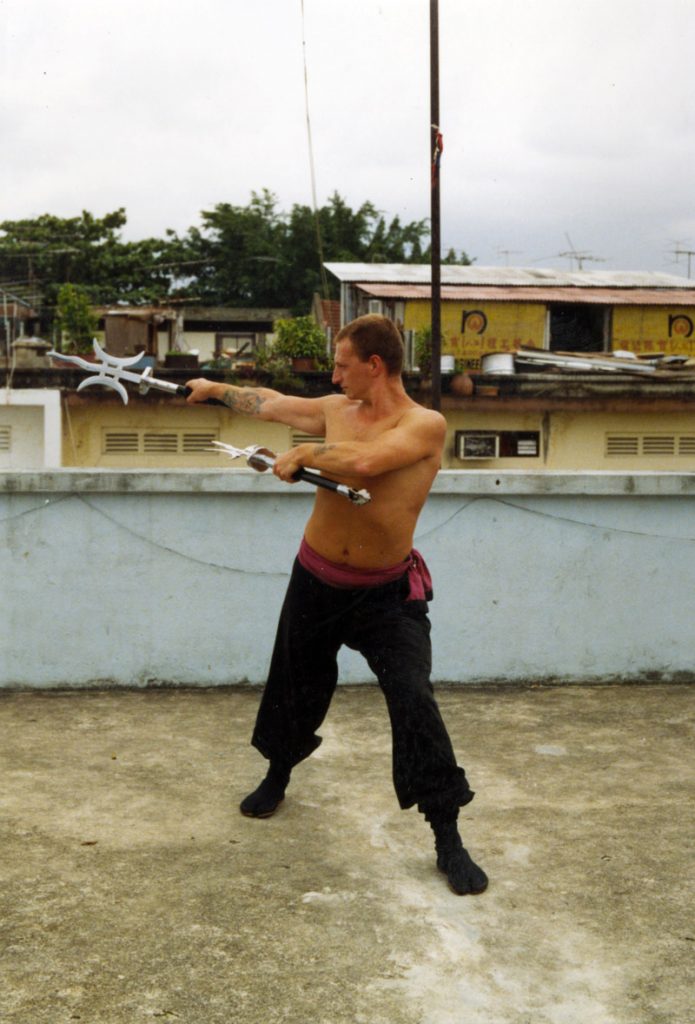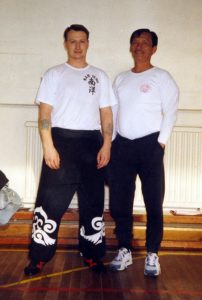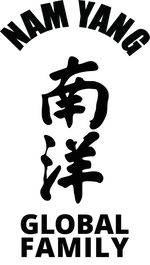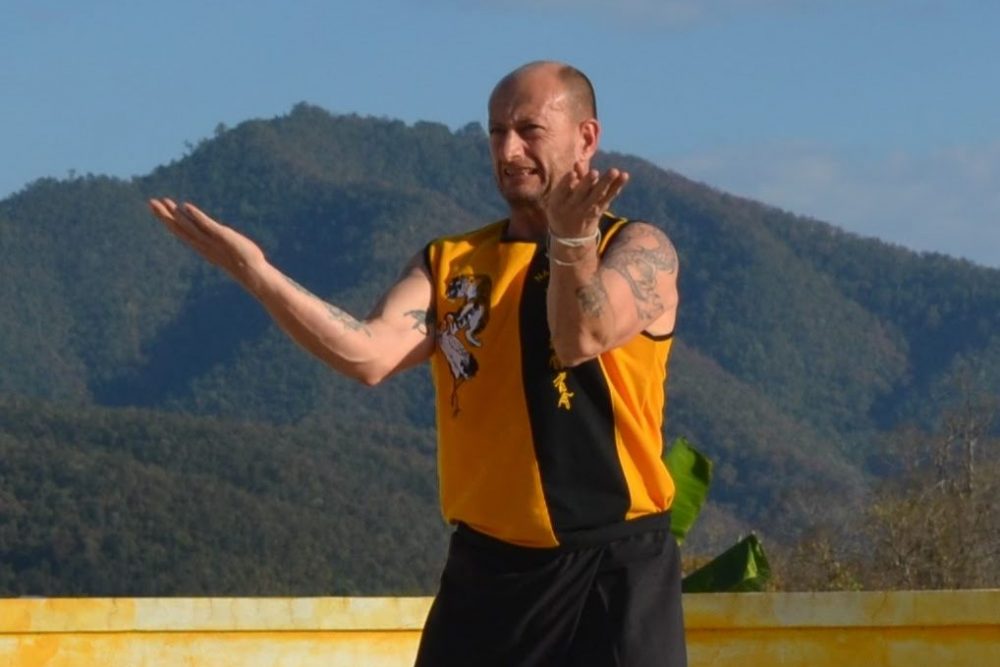Master Iain Armstrong training Sum Chien at the Nam Yang Kung Fu Retreat, Thailand in 2017 – 36 years after the story began. The secret of real Chinese kung fu training is not to give up.
This short, superficially simple routine is the core training exercise of not only Southern Shaolin kung fu but also many styles of karate. It must be one of the most widely practised yet least understood martial arts exercises and is still shrouded in mystery. Here I describe how, over the last three decades, the mystery has unfolded to me personally\

Kung Fu training. Author Master Iain Armstrong on the flat roof of the old Nam Yang Pugilistic Association headquarters in Lorong 6, Geylang, Singapore in 1989.
Kung Fu Training: Laying the Foundations
When, as a teenager, I made the decision to commit myself to kung fu training I was buying into a dream. A dream of ancient Masters who could tame bandits with a glance, of monasteries nestled in mist shrouded mountains, of Shaolin monks who could crack granite with their bare hands and of handsome, sharply suited, oriental hitmen who could kill with the lightest touch, leaving not a trace. I didn’t really take up kung fu because I needed to learn to fight. I knew that I needed to get better at fighting but I already had more experience than most people will gather in a lifetime. The reality, however, is not quite what you might expect. Cracking heads into damp grey pavements and ramming faces into dusty shop windows on cold, starlit nights is certainly exciting but it hardly counts as living the dream. As a famous kung fu Master would say to me many years later ‘if you take a bus, you need to know when to get off’. I always remember that quote! To me, kung fu meant magical herbs, golden Buddhas, deep meditations, conversations with spirits and a whole world of untapped opportunity. It was the stop where I wanted to get off the bus.
Thirty-two years later I am still on that same kung fu journey and I have not been disappointed on a single count. The path is not an easy one. My kung fu training started with a great deal of sweaty, painful physical work and progressed through a complete dismantling of my old self to build the new one. Along the way I have watched spirit possession, lived amongst secret societies and cracked bricks with my fingertips. I even had a face off with a god who guards the gates of hell in an incense scented Singapore backstreet, right in the middle of the red-light district! In the end, I have simply confirmed what I knew in my heart right from the outset: kung fu is a way to free the spirit from itself imposed chains, to live a better life and to unlock the full human potential. It sounds great, but nothing comes without a price. The Chinese words ‘kung fu’ translate more or less as ‘a man hard at work over a long time’. If you want to unlock the full power of kung fu, it is not going to be easy: you are going to have to work, you are going to have to sacrifice and you are going to have to suffer – over a long time. There really is no such thing as a free lunch.
My teacher, Master Tan, who is a direct line descendent of the Southern Shaolin tradition, was always careful to point out that there are many routes to the top and that no way is the only way. The way we took was the one which is practised in the Southern part of Fukien province, know as Min Nam – South of the Min river. Although the exact location of the Southern Shaolin Temple, (the one which was burned to the ground by the Ching army and thus inspired the greatest martial arts legend), is still a point of controversy it is accepted that it indeed lay within this ‘Min Nam’ area. So it is fair to assume that the martial arts of this area – which are very unique in character – are the closest that remain to those of the legendary temple and its immortal warrior monks. Although these arts have diverged into a number of different branches, they are linked together by the fact that they almost all centre their training around a short and superficially simple training routine called ‘Sum Chien’ meaning ‘three wars’ or ‘three battles’. So for us, the hard work started with ‘Sum Chien’. It has never finished.

Grand Master Tan Soh Tin with Master Iain Armstrong in England whilst taking a break from Kung Fu training in 1995.
I was told, from the outset, that Sum Chien was the key to our art. Within it lay the true essence of the art and indeed if I was to master Sum Chien I would have mastered ninety percent of the art. I didn’t understand. So I just knuckled down and practised. In all of the battles that we had back on the London streets, it had been a pretty good rule of thumb that the biggest, strongest most aggressive men had the advantage. Kung fu Masters were different and that fascinated me. Master Tan and his colleagues were mostly old, quiet, inoffensive and not at all physically imposing – at least in comparison to what I was used to. And yet their skills could beat brute force. I remember a time when I was still a very junior student and Master Tan asked me to punch him so that he could demonstrate how to bounce back the energy of a punch. Being wary of the old Master I threw a very controlled punch towards him so as to be sure not to hurt him. He gave me that withering look which I was soon to get used to. ‘Iain, that was not a punch! Don’t treat me like a fool, throw me a real punch.’ I had boxed for a few years and so as not to hack him off any more, snapped out a sharp left jab. He caught it on his shoulder, rolled back with it until it ran out of energy, then flicked the energy that he had absorbed back down my extended arm to tip me off balance. More than any other single incident, this is what sold it to me. This was why I knuckled down and practised. I had seen what was out there and I wanted a piece of it. If that meant practising Sum Chien all day so be it. Well, to a large extent it did mean practising sum chien all day!
It took a long time and a lot of trips to Singapore to persuade Master Tan that I was really worth teaching. In 1993 I won gold medal in a world kung fu championships held in the USA for demonstrating my weapon skills. Around about this time he seemed to make up his mind that he was going to teach me properly. So we went right back to the beginning and worked on stance. We continued for a long time – many years in fact. Stance, body posture, relaxation. ‘Work on the basics. Build a solid foundation. To build a strong art you need a strong foundation. Sink into your stance. Extend your Chi into the Earth and grow roots.’ Gradually Sum Chien came to life. I learned the body mechanics needed to overcome stronger opponents. I learned breathing techniques to ‘supercharge’ internal organs with Chi. I learned to store energy in different parts of the body and release it in an explosive burst. I learned to sharpen my senses and develop a sixth sense, as Master Tan calls it. I learned to use my eyes in ways that I had not even contemplated before. I can describe to some of the secrets that Sum Chien holds but without the hard work you will never master them.
A lot of my most influential lessons took place in bustling Singapore coffee shops and hawker centres, (little markets made up of cooked food stalls). The food was amazing. We would sit on small plastic stools around battered formica tables amongst the smell of stir fries and cigarette smoke tucking into Hokkien noodles or maybe chilli stingray and he would say:
‘Iain. Never Forget That, At The Most, The Teacher Can Give You Fifteen Percent Of The Art. The Rest You Have To Get For Yourself Through Practise And Hard Work. I Can Show You The Path But I Can Not Walk It For You.’
As always, it was sound advice.
In the following parts of this series of blogs, I will explain to you here some of what Sum Chien holds – but to gain it for yourself you will need to do the hard work. I hope you enjoy the journey!
One of Master Iain’s best articles, definitely worth reading. Very detailed analysis of Sum Chien, written in 2013.
Link to the original article on Master Iain’s Blog: https://kungfuretreat.com/kung-fu-training-laying-the-foundations/

